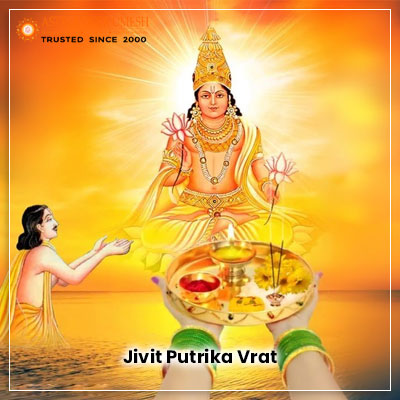


Jivitputrika Vrat, also known as Jitiya Vrat, is a three-day festival celebrated across regions like Bihar, Uttar Pradesh, and Jharkhand, as well as in Nepal. This festival holds deep cultural and religious significance as mothers fast for the well-being of their children. In 2024, it will be observed on September 25 and signifies the devotion of mothers seeking blessings for their children's health and happiness. The history of this festival dates back to the legend of King Jimutavahana, highlighting themes of kindness and protection.
Jitiya Vrata: An Auspicious Fast for the Well-being of Children
Background
Jitiya Vrata, also known as Jivitputrika Vrata, is a significant three-day festival celebrated in regions like Bihar, Uttar Pradesh, Jharkhand, and Nepal. This festival holds deep cultural and religious importance, as mothers observe strict fasting for the health, happiness, and longevity of their children.
According to legend, the festival originated in the story of King Jimutavahana. The king was once cursed to become a demon, and it was predicted that his curse could only be lifted if his mother, Mai Jiutiya, performed a fast and prayed to Lord Indra. With unwavering devotion, Mai Jiutiya observed the fast, and her son was eventually freed from the curse.
Significance
Jitiya Vrata is a testament to the boundless love and sacrifices made by mothers for their children. Mothers who observe this fast believe that it brings divine blessings, protects their children from harm and illness, and ensures their well-being. The festival also strengthens the bond between mother and child and fosters a sense of community among women who share the same aspirations for their children's happiness.
Observances
The festival is typically observed from the eighth to the tenth day of the waning moon during the month of Kartik (October-November). During this period, mothers refraining from any food or water. They spend their time in prayer, meditation, and performing rituals.
On the first day (Nahan), mothers take a ritual bath and offer prayers to Goddess Jivitputrika. On the second day (Nirjal Diwas), they observe a complete fast and engage in intense worship. On the third day (Paran), the fast is broken with a special dish called "ras" made from pumpkin and rice.
Top 5 FAQs
1. When is Jitiya Vrata observed in 2023?
2. What is the significance of the pumpkin in Jitiya Vrata?
3. What are the benefits of observing Jitiya Vrata?
4. Who can observe Jitiya Vrata?
5. What is the historical significance of Jitiya Vrata?
Conclusion
Jitiya Vrata is a cherished festival that celebrates the unbreakable bond between mothers and children. Through fasting, prayer, and rituals, mothers express their love and devotion, seeking divine blessings for the well-being and happiness of their loved ones. It is a festival that preserves the rich traditions of Hinduism and strengthens the bonds of family and community.

As Diwali celebrations come to an end, the day after is marked by the auspicious festival of Govardhan Puja or Annakut. In 2025, this festival falls on Wednesday, 22 October, and is a reminder to express gratitude towards nature and the environment. Devotees prepare special offerings and decorate their homes with flowers and diyas, honoring Lord Krishna and the bounty of nature. While the article provides general guidance, it also urges readers to consult experts before implementing any beliefs or practices discussed.

The Udupi Catholic diocese has extended warm Diwali greetings, citing the festival as a symbol of moving from darkness to light, falsehood to truth, and death to new life. The diocese emphasizes India's diversity and unity in celebrating different festivals together. Sharing a symbolic story, the diocese urges people to be the candle of hope that relights peace, faith, and love in the world. The message concludes with a call to action to be the light that builds bridges of love, faith, and compassion.

The Hindu Vikram Samvat calendar marks October 22, 2025, as Gujarati New Year, a day of renewal, positivity, and joy for devotees. From early morning prayers to temple visits, sweets, and sharing warm messages, the day is a festive symbol of hope and abundance. As it falls a day after Diwali, it's also a time to open new accounts, perform rituals like Chopda Puja, and spread love, gratitude, and togetherness with family and friends.

As Diwali celebrations come to an end, Mumbai is facing a major problem of poor air quality. The city is engulfed in a thick layer of smog, with visibility reduced to minimal in some areas. The situation has been worsened by unseasonal rain, with no significant improvement in air quality. It is not just Mumbai, but several other cities in India are also dealing with pollution levels breaching the "very poor" and "severe" categories. With AQI readings hitting 380 in some areas, measures need to be taken to combat this worsening air quality situation.

Kiran Mazumdar-Shaw, founder of Indian biotech giant Biocon, met with top government officials in Karnataka, including Chief Minister Siddaramaiah, to discuss the city's deteriorating infrastructure. This follows a recent social media post where Shaw called out the government for their ineffective management and lack of accountability. With heavy rains expected in the coming days, these concerns take on even more urgency as residents brace for potential waterlogging and traffic congestion.

Hospitals in the city have reported an increase in burn cases linked to the celebration of Diwali, with over a hundred cases reported at AIIMS Delhi alone. Despite the worsening air pollution, no major increase in respiratory distress cases was seen, but senior doctors anticipate an increase in the coming days. Several patients who suffered burns during the festival recounted how even seemingly harmless firecrackers resulted in severe injuries. While most cases were minor, a total of 129 patients were treated for firecracker-related injuries at Safdarjung Hospital.

Diwali, the festival of lights, is a celebration of good over evil and light over darkness. This festival is rooted in a rich history of mythological connections, with Hindus commemorating Lord Rama and his victory over the demon king Ravana. However, Diwali is not limited to just one faith - it is celebrated across beliefs and traditions, including Jains, Sikhs, and Newar Buddhists. Festivities and celebrations during this time include illuminations, rituals, feasting, and community gatherings, making it a time of joy, renewal, and gratitude.

Maharashtra Chief Minister Devendra Fadnavis honors the brave officers who sacrificed their lives in an ambush laid by Chinese troops in Ladakh. He pays respects at the martyrs' memorial on Police Commemoration Day, highlighting their inspiration for courage and integrity. The event is observed annually to remember the 10 valiant policemen who lost their lives in the line of duty.

Prime Minister Narendra Modi marked Diwali by joining the armed forces aboard INS Vikrant, India’s indigenous aircraft carrier. A cultural programme on the vessel, showcasing the creative talents of naval personnel, left a lasting impression on the PM. He took to Twitter to express his admiration for the emotional and artistic depth within the armed forces, highlighting the symbolic power of Diwali – light triumphing over darkness – as a reflection of India’s growing strength.

On the sacred occasion of Diwali and the Hindu New Year, His Holiness Mahant Swami Maharaj extended blessings to BAPS followers worldwide. In a handwritten letter, he encouraged individuals to celebrate a Diwali that glows within the soul and radiates throughout society, with lamps of service, humility, and righteousness. He prayed for universal well-being in the New Year and reminded devotees to ignite the flame of virtue in their homes, not just through lighting lamps but also through acts of love, compassion, and service.